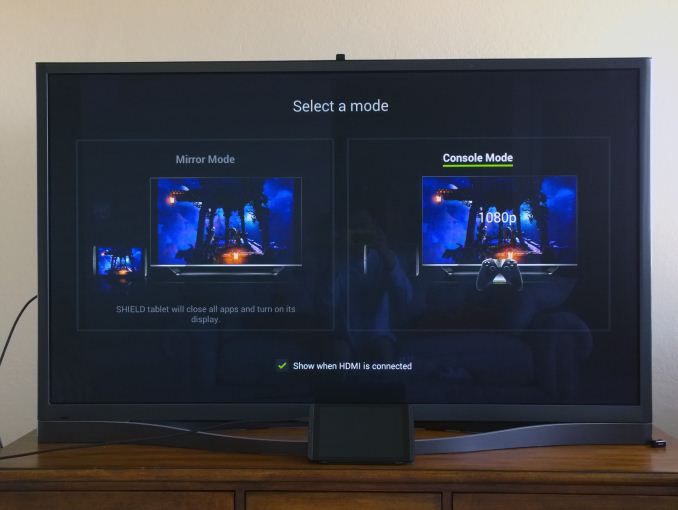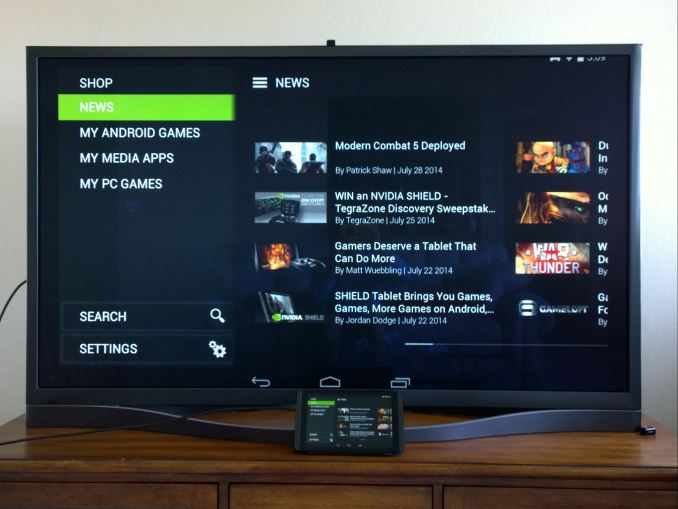The NVIDIA SHIELD Tablet Review
by Joshua Ho on July 29, 2014 9:00 AM ESTSoftware
In the UI department, there’s not too much to talk about. Much like Motorola, NVIDIA has stuck to using the AOSP UI design. Of course, there are plenty of NVIDIA-specific applications, but I didn’t run into any issues using the tablet to do everyday tasks. In this respect, things have improved massively over Shield portable. Because this tablet works in both portrait and landscape, there aren’t any issues with applications that force portrait mode like there were with the Shield portable. In normal tablet usage, it works as one might expect, with no real perceived lag throughout the UI. Of course, this is when compared to other Android devices. There are still frame drops involved in scrolling through lists and similar areas where Android has traditionally struggled to stay smooth, but Android L should fix this issue for the most part.
DirectStylus 2
The real value that the Shield tablet brings as a tablet is the stylus functionality. DirectStylus 2 is definitely much, much better than any other capacitive stylus on the market. The tip allows for precise control and it’s definitely responsive to changes in pressure. For the most part, there are only small issues here. Because the stylus is capacitive, it’s not really possible to have a floating pointer the way Wacom styluses do. In addition, I noticed that I need to lift the stylus a bit more than I might with pencil and paper in order to start a new letter or word or else my words would start to flow together. For the most part though, it works well enough, and the inking latency is low. Unfortunately the issue here is more of ecosystem than hardware, as most stylus-enabled applications aren’t nearly as robust as OneNote on Windows x86.
Console Mode
Of course, the real question here is whether the gaming side is worth the price premium. NVIDIA has gone all out on this area, and their efforts are split up into multiple aspects. The first is the TV interface/console mode, then the gameplay recording feature known as ShadowPlay. Finally, there’s the aspect of GameStream and GRID, which make it possible for games to be played on the tablet that otherwise wouldn’t work due to the compute requirements.
The TV interface effectively boils down to Shield Hub and Google Now, although it’s fully possible to use the full tablet UI as desired in this mode. In the hub, launching games and various applications like YouTube and Netflix is rather simple compared to the more cumbersome full Android UI as they have their own category in Shield Hub. In addition, launching applications through Google Now works as expected. Overall, there aren’t any friction points here. It works as well as one could expect. There is a strong reliance on voice input in general, but it’s much better than trying to type with a controller and better than most smart TV experiences. While the TV interface is mostly targeted towards enabling a console gaming experience, YouTube and Netflix both work great in this mode. NVIDIA has also gone through the necessary DRM certification process to allow for 1080p Netflix streaming. In essence, this device is already ready to serve as an Android TV device.
ShadowPlay
ShadowPlay, which we first saw in GeForce GTX GPUs, is also another major advantage that NVIDIA brings to the table for software experience. In short, this leverages the hardware H.264 video encoder that is on the Tegra K1’s Kepler GPU to provide video capture of gameplay or anything else displayed by the tablet. There are three possible options for video capture. The first is Twitch broadcasting, something that NVIDIA is quite proud of as they are the first to implement such a feature in an Android tablet. While I personally don’t stream on Twitch, a demo of Twitch broadcasting in the initial launch briefing worked without any visible quality issues in either audio or video.
There are two other recording modes. One is a standard start/stop recording feature, but the other is ShadowPlay/Auto Recording. In short, this keeps anywhere from the past minute to 20 minutes in video. This makes it possible to set and forget about the recording feature rather than constantly managing recordings in manual mode. All of these modes can use the tablet’s microphone and front facing camera for commentary purposes as needed. Local recordings seem to have a maximum of 1080p30, and Twitch broadcasts are limited to 720p30.
While those are the technical details, it’s a painless process. All the user has to do is long press the back button on the controller and select what kind of a recording they’d like to do (Twitch, Auto, Manual, Screenshot) and that’s it. I can see significant potential in this area especially if this device takes off as a gaming platform.
















174 Comments
View All Comments
sherlockwing - Tuesday, July 29, 2014 - link
If and only if you are color blind.Moizy - Tuesday, July 29, 2014 - link
Crappy? It's no iPad Air or Nexus 7, but it's still good. Read Josh's article from the other day where he went back to the archives and tested smartphone panels that were once awesome in their day. Just 3 years ago we were praising the contrast of SAMOLED and the great resolutions those phones had. The Shield Tablet is leaps and bounds ahead of them, in accuracy, gamut, and pixel density, and just a tier below the iPad Airs and Nexus 7s of the world. For $300 and all this tablet can do, I would highly recommend this tablet to most anyone, and still plan on getting one for work and graduate school.boozed - Tuesday, July 29, 2014 - link
After reading "crappy" I was expecting a much worse result than the reality expressed in the review, so that's an exaggeration.I wouldn't be surprised if this screen still outperforms the majority of desktop gaming monitors out of the box.
edlee - Tuesday, July 29, 2014 - link
this soc it a powerhouse, nvidia is stupid that they do not mass produce it for mass produced products from HTC and Samsung. They made tablet GPU that is faster than Intel HD4000, which is pretty significant.But Nvidia doesn't have enough brand cognition for the simple consumer to know this is a killer product, not sure why you dont hear more partners for this soc.
melgross - Tuesday, July 29, 2014 - link
They do, but few manufacturers seem to want their SoC's.johnny_boy - Tuesday, July 29, 2014 - link
I don't get why since they make a pretty damn compelling SoC. Sure, previous generations weren't very exciting, but those were previous generations!phoenix_rizzen - Tuesday, July 29, 2014 - link
Fool me once (Tegra1), shame on me.Fool me twice (Tegra2), shame on you.
Fool me thrice (Tegra3), screw you!
Fool me a fourth time (Tegra4), I'll never listen to you again.
After all the hypocrisy and broken promises and what not from nVidia from the previous generations, is it really any wonder that no one wants to trust them again? All the big phone/tablet manufacturers are going to sit out this round and let nVidia go it alone. Maybe some smaller vendors will nibble at the line, and maybe some of them will have some successes with Tegra K1. But you won't see any major vendors using Tegra K1 until it proves itself in the market.
If nVidia hadn't burned so many bridges with Tegras 1-3 they'd be in a better position to take on Qualcomm, Samsung, ARM, and Intel. But, even with how good this SoC may be, it's still too little, too late.
Don't screw over your customers if you want them to be repeat customers!
TheJian - Wednesday, July 30, 2014 - link
You're mistaken. It was the only thing at google IO. In their automotive, their developer device (tango), TV, and it seems nexus tablet coming for gamers (9in IIRC).Too little too late? ROFL. It dominated the 805 and everything else here. Right on time is more like it. It will be in Google's Nov HTC Nexus 9 tablet at least. Mipad from xaiomi, Lenovo Thinkvision AIO 28, of course Jetson dev board also. I'm guessing A shield R2 coming shortly too with 1440x810 as the other specs that floated around showed (which clearly isn't this tablet, and it supposedly has 4GB ram, so again not this device). Small volumes right now probably prevent a dual launch of both shield products or they may wait for Denver since there is already quite a bit of interested parties using it as noted. If all you can produce goes to the above mentioned devices shield 2 may have to wait a bit.
akdj - Sunday, August 3, 2014 - link
Unfortunately, when ya want the 'power'. The promise of the 'performance'. And probably most importantly in today's mass market, it's 'efficiency'. Sure, they're flat hauling ASS in these benchmarks @ full tilt but a couple hours off the wall and you're done (with a AAA game that's the main draw to this tablet, right? --- I can't imagine the 'power' browser, or super reader or the 'AA' games I'm enjoying , Dark Room, The Room. Sometimes ya die. Maybe some car racing and if I've got the time an RPG FPS or an MMO, it's rare. In fact with my nine year old son it's 'his' time on my iDevices playing the games, the AA games that kick incredible ass but aren't AAA because they're not in a computer, console or dedicated gaming system. Laughable. I'm 43 and Ultima, Myst and Diablo A & B. Not the latest. Those were my games. Ultima online, I don't have the time nor do most 'tablet clients'. This is a niche product and an SoC with extreme limitations if you're taxing it's power. Obviously, using it as a movie watching, media browsing and light productivity....it's amazing efficiency. But, argument of color aside....we are moving to a HiDPI world with excellent color production on phones, tablets computers and TVs/4k, et al. If the screen is subjectively by the author after objective measurements confirming it.... 'Washed out' sounds lame. So does a pair of hours if I want to game a bit while on a three plus hour flight. A8 from Apple, Quallcomm NAND their 64bit architecture, significantly deeper libraries of apps, games and general interest software, Apple and Samsung, nor Google or ASUS, HTC LG or ABC going to take this risk again and it's exactly that. A speed demon you're unable to take advantage of if you're away for a charger. And a tablet plugged in = a major PITA. SoCs have to strike a balance. And with Metal/A8/Continuity and Google's response to come. Samsung's readying the new Note 4. Possible 805? With the 420, it'll fly through a helluva lot of games. And it's display is going to best the best today. The S5 from the same family. AMOLED has come a long way. IPS display with 'washed out' colors isn't appealing.akdj - Sunday, August 3, 2014 - link
No edit. Wasn't supposed to be Quallcom's NAND. Rather Qualcomm and their 64 bit response to second generation 64bit A8. Cool and exciting to have the completion but yeah, burned three times it was tough to trust a fourth gen to leave the shelf without the reliability of ARM, Snapdragon and the 'A' series Apple tweaked ARM SoCs. Both dedicated AND delivering with incredible improvements. Look at Note 1-->Note 3's benches. iPhone 4-->5s. Two years and mind bending speed, efficiency and even more software ('apps') then before with more possibilities. Intel now in w/BayTrail, I'm wishing nVidia the best. I'm a fan